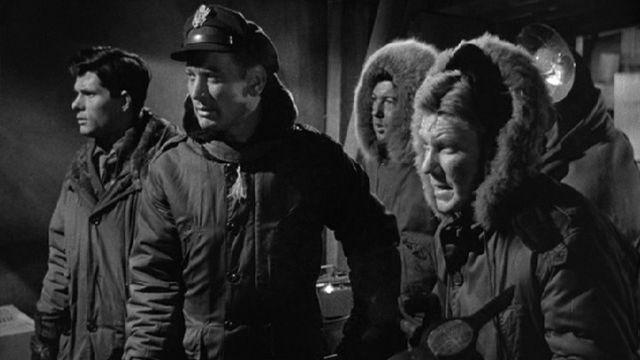The Thing from Another World (1951) 
“Where Did It Come From? How Did It Get Here? WHAT IS IT?”

Director: Christian Nyby, Howard Hawks
Cast: Kenneth Tobey, Margaret Sheridan, James Arness
Synopsis: Scientists and American Air Force officials fend off a blood-thirsty alien organism while at a remote arctic outpost.
Tapping in to the American public’s mistrust of the rate of scientific progress in the wake of the devastating bombings of Hiroshima and Nagasaki in the dying days of WWII, writer John W. Campbell Jr., with the uncredited aid of producer Howard Hawks — who may or may not have directed much of the movie (depending on what day of the week it is, and in which direction the wind is blowing) — and Ben Hecht took Charles Lederer’s novella Who Goes There? (which, in its original form, would appear to be more suited as a metaphor for Communist infiltration) and fashioned a tense, absorbing SF movie which pitted the thirst for scientific knowledge against the need for military defence.
Kenneth Tobey, familiar to millions of middle-aged children as Chuck Martin from The Whirlybirds, plays USAF Captain Patrick Hendry, who is despatched to a scientific research centre in the North Pole after its chief scientist, Dr. Carrington (Robert Cornthwaite) reports that an unidentified craft has crashed nearby. Carrington’s something of a queer egg with his neatly trimmed silver goatee, his vaguely swish manner, and a blazer more suited to the proud owner of a modest yacht than the head of an important scientific mission. Right off, we’re a little suspicious of Carrington: where’s his white lab coat? Why can’t we see pens poking out of the top of his chest pocket? Where’s his clipboard? These important questions don’t appear to trouble Hendry at first, but it’s not long before he starts to get the measure of the man.
The research facility is manned by a number of people, all but one of whom is male. Most of them are sort of interchangeable, with little in the way of individual personalities, although there is one big guy who just seems to stand around a lot with his hands in his pockets. There’s also a reporter, transported there by Hendry for some publicity work presumably, although his presence seems to be just a little contrived. His name’s Ned ‘Scotty’ Scott (Douglas Spencer), and he’s one of those stereotypical, mouthy, wisecracking journalists that sort of became extinct in the 1960s. That non-male member of the centre is Nikki Nicholson, played by Margaret Sheridan, a protege of Hawks’ whose career faltered when she placed motherhood above stardom. For a 1950s female, Nikki is quite calm and unflappable, but she still spends a lot of time asking anyone if they’d like a cup of coffee.
Upon locating the site of the crash, Hendry and the others soon realise that they’ve found themselves a flying saucer, and decide to release it from the packed snow and ice into which it has ploughed by using thermite heat bombs. I don’t know what thermite heat bombs are, exactly, but anything with the word bomb in it has negative connotations and, sure enough, all the crew succeed in doing is blowing up the spaceship they were trying to free. However, it’s not all bad news, because their Geiger counter picks up signs of radioactivity nearby, and a brief search unearths an alien body buried in the ice.
Naturally, once they have the block of ice in which the alien is encased back at camp, the scientists are keen to thaw it out, but perhaps realising the faux pas he committed by blowing up the first alien vessel to ever land on earth, a vessel which would probably have given human technological progress a massive leap forward, Hendry won’t allow them to do anything until he gets his orders from HQ. Best to leave the entombed alien in a storage room with an armed guard, safe and sound where nothing can go wrong. Unless, that is, someone doesn’t realise that the electric blanket they’ve thrown over the ice after getting spooked by the alien within is actually switched on. Before you know it the alien (James Arness) is awakening in a muddy puddle, and is more than a little ticked off that this bunch of puny earthlings have blown up his spaceship. To be fair, you can’t really blame him for being ticked off — after all, driving into one tiny planet in the vastness of space by far surpasses driving into a signpost on the side of the road in terms of carelessness, but then to have the locals — whom you consider to be nothing but a food group — accidentally destroy it must really take the biscuit.
Ironically, The Thing, John Carpenter’s 1982 remake of this movie, is probably closer to Lederer’s novella than Hawks and Nyby’s version, because it employs Lederer’s device of having the alien capable of assuming the appearance of any living organism it comes into contact with. The element of paranoia that forms such a focal point of Carpenter’s movie is completely absent from the 1951 version meaning that it’s essentially just another monster on the loose movie. It’s certainly well done for its time, but its decision to focus on the conflict between science and self-protection robs it of a rich source of suspense. Eventually, Carrington’s repeated insistence that nobody harms the alien, no matter how violent it turns, starts to sound like the unrealistic refrain of some tree-hugging fanatic who will entertain no opinion other than their own. It’s an obsession which defies logic and reason, and Carrington’s complete lack of any sense of self-preservation just doesn’t ring true. Scientific research, after all, is built upon empirical observation, and no scientist ever received a clearer and more obvious indication of the uncontrollable risk posed by the alien.
(Reviewed 17th September 2013)
httpv://www.youtube.com/watch?v=T5xcVxkTZzM
